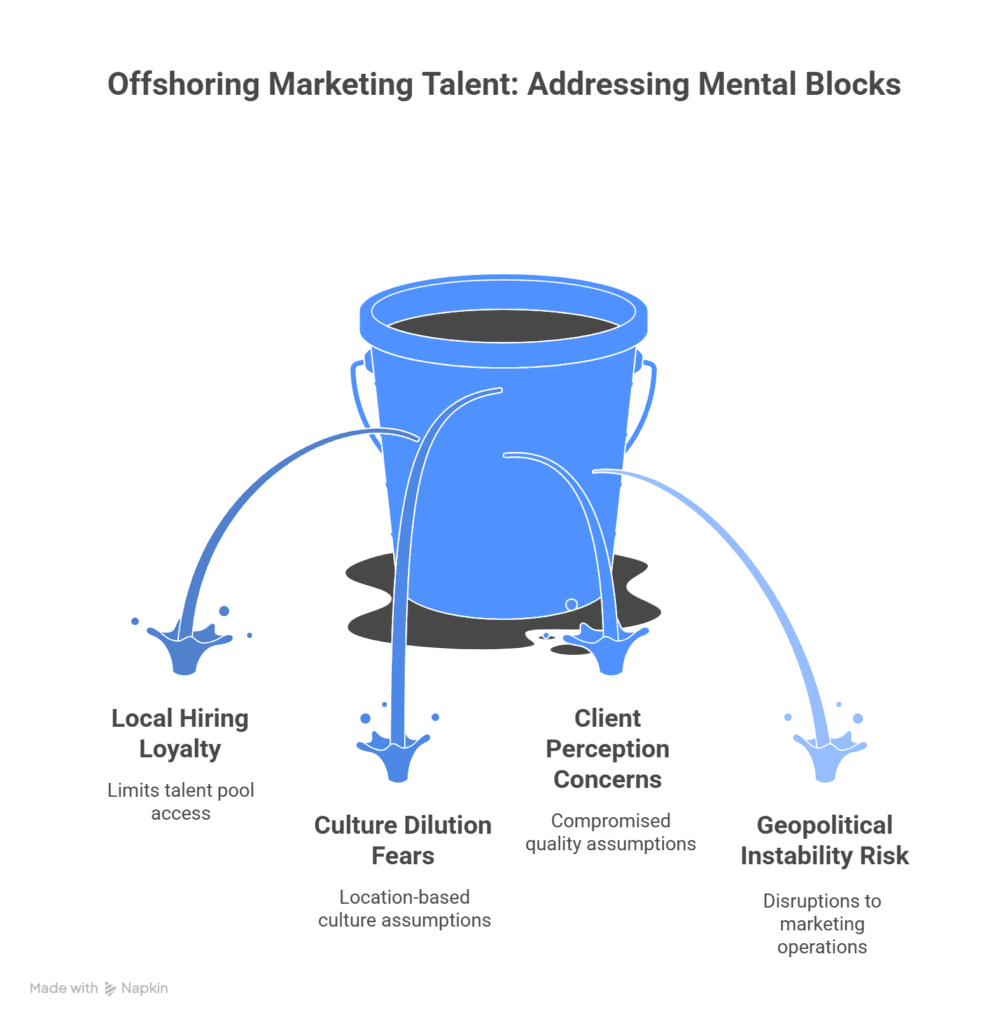Offshoring marketing talent can offer significant benefits like cost savings and access to a global talent pool. But, many businesses hesitate due to common objections that can cloud decision-making. You might worry about communication barriers, cultural differences, or the quality of work produced by remote teams.
Understanding these concerns is crucial for making informed choices about your marketing strategy. In this article, we’ll explore the most frequent objections to offshoring marketing talent and provide insights to help you navigate these challenges effectively. By addressing these issues head-on, you can better assess whether offshoring is the right move for your business.
1. Fear of Losing Control Over Brand Voice and Quality
Many businesses hesitate to offshore marketing talent due to fears surrounding brand voice and quality control. Concerns often arise about whether an overseas team can truly represent a company’s tone and messaging.
Addressing these fears directly can ease your anxiety and improve your overall strategy.
Can Overseas Teams Match Our Tone and Messaging?
Yes, overseas teams can match your tone and messaging with the right tools and strategies. Start by sharing your brand’s core values, audience insights, and preferred communication style.
Provide examples of previous campaigns that exemplify your voice. For best results, create a comprehensive style guide that includes dos and don’ts for messaging. This roadmap helps overseas teams align their work with your brand identity.
How to Document Brand Guidelines and ICP for Global Teams
Documenting brand guidelines and your Ideal Customer Profile (ICP) boosts clarity for global teams. Create a concise brand guideline document that includes:
- Voice and Tone: Outline your desired communication style.
- Visual Identity: Provide specifications for logos, colors, and fonts.
- Target Audience: Clearly define your ICP by demographics, behaviors, and preferences.
Make this document accessible and easy to update. Regular training sessions ensure all team members stay aligned and informed about changes.
Training Offshore Marketers with Loom, Notion, and Slack
Utilizing Loom, Notion, and Slack effectively trains offshore marketers. Use Loom to deliver video tutorials on specific tasks and brand messaging. Notion serves as a centralized hub for your guidelines, project updates, and important documents.
Leverage Slack for real-time communication and quick feedback loops. Regular check-ins can help maintain quality and provide immediate support for team members needing clarity.
QA Processes to Review Creative, Copy, and Strategy Output
Establishing rigorous QA processes eliminates quality concerns. Carry out a three-step review system:
- Internal Review: Team members review their work first.
- Peer Review: Another team member assesses the work for alignment with guidelines.
- Final Approval: A senior team member or manager gives the final go-ahead.
This structured approach ensures that every piece of content flows seamlessly with your brand voice and meets quality standards before going live.
2. Concerns About Communication and Time Zone Barriers
Communication and time zone differences often raise red flags when contemplating offshoring marketing talent. Many businesses worry about the impact on collaboration and execution.
Let’s break down these concerns.
Will Async Work Slow Down Execution?
Async work does slow things down, but it doesn’t have to derail your projects. Delays happen, yet managing expectations helps. Set clear deadlines and specific objectives. Use collaborative tools like Trello or Asana to track progress.
Document everything to keep your offshore team in sync. By fostering a results-oriented culture, you maintain momentum.
Setting Overlap Hours and Response SLAs for Offshore Teams
Overlap hours matter. Establish a few hours where teams can meet live, fostering real-time communication. Set response Service Level Agreements (SLAs) too. Define acceptable timeframes for replies to emails or messages.
These steps foster responsiveness and accountability, ensuring that both teams feel connected and focused on shared goals.
Structuring Weekly Reviews and Campaign Syncs Remotely
Weekly reviews keep everyone on the same page. Schedule recurring meetings to discuss campaigns and performance metrics. Use these syncs to share insights and feedback. When distant teams review results together, they build trust and collaboration.
This process amplifies accountability and encourages a learning culture across your global teams.
Nearshore vs. Offshore for Time Zone Compatibility
Nearshore options can simplify time zone challenges. If your teams are in neighboring countries, communication improves. Consider this flexibility when selecting locations. Nearshore partnerships often lead to smoother interactions and quicker resolutions.
But, if offshore talent brings unique skills, the trade-offs may be worth it. Weigh these factors based on your specific needs and the markets you serve.
3. Assumption That Offshore Talent Is Lower Quality
You may believe that offshore talent lacks the necessary skills or competencies. This perception stems from misconceptions rather than reality. Many offshore professionals deliver high-quality work. By understanding the dynamics of the market, you can find top-tier talent that meets your needs.
Why Geography Doesn’t Equal Competency in Digital Marketing
Talent isn’t confined by borders. Many skilled marketers work in various regions, showcasing expertise in digital strategies and tactics. Focus on qualifications rather than location.
Look for professionals who excel in best practices, which can include certifications from reputable organizations, showcasing their knowledge and commitment to the field.
Hiring Based on Case Studies, Test Projects, and Output
Evaluate potential hires through a structured approach. Request case studies that demonstrate their past successes. Assign test projects relevant to your business to see their practical skills in action. Assess their results and methodologies.
This allows you to gauge their ability to deliver before making long-term commitments.
Common Roles With Proven Success Offshore: SEO, PPC, Email
Certain marketing roles consistently deliver strong results in offshore environments, especially when supported by clear processes and performance expectations.
- SEO Specialists manage keyword research, on-page optimization, technical audits, and link-building strategies to grow organic visibility and traffic.
- PPC Advertisers handle Google Ads, Meta Ads, and other platforms with precision, optimizing budgets and creatives to maximize return on ad spend.
- Email Marketers build and automate campaigns in tools like Klaviyo, Mailchimp, and HubSpot, using segmentation and personalization to drive conversions.
- Content Writers produce high-quality blog posts, landing pages, ad copy, and social content aligned with brand tone and SEO goals.
- Marketing Designers create graphics for ads, emails, social media, and web pages, working in tools like Figma, Canva, or Adobe Creative Suite.
- Marketing Operations Specialists manage CRM workflows, build automations, maintain contact lists, and support campaign execution across tools.
- Analytics and Reporting Analysts consolidate campaign data from various platforms, build dashboards, and track KPIs to guide decision-making.
- Social Media Managers schedule posts, manage engagement, and monitor performance across platforms like LinkedIn, Instagram, and Facebook.
- Video Editors transform raw footage into branded video content for organic and paid distribution on platforms like YouTube, TikTok, and Instagram.
These roles are well-suited to offshore teams because they rely on digital tools, follow repeatable workflows, and produce measurable outcomes. Offshore professionals in these positions often bring a high level of technical skill, strong communication, and cost efficiency—making them a reliable extension of your internal team.
Talent Pools in Egypt, Kenya, and LATAM
Emerging markets like Egypt, Kenya, and Latin America (LATAM) offer a wealth of talent. Each region has developed robust educational programs and training in marketing disciplines. You can tap into these talent pools for skilled professionals who understand both local and global markets.
Leverage regional strengths to enhance your marketing capabilities.
How to Set Expectations, KPIs, and Quality Gates
Setting clear expectations is crucial. Define Key Performance Indicators (KPIs) that align with your business objectives. Communicate these clearly to your offshore teams. Establish quality gates throughout the project lifecycle to ensure standards are met consistently.
Use regular check-ins and feedback loops to keep everything on track. This proactive approach fosters accountability and reinforces your standards for success.
4. Perceived Risk Around Security, Data, and Compliance
Concerns about security, data privacy, and compliance can halt your offshoring plans. Many business owners worry about how to protect crucial customer data when using remote contractors. You grapple with fear over data breaches, identity theft, and non-compliance with regulations like GDPR or CCPA.
Is My Customer Data Safe With Remote Contractors?
Customer data safety hangs in the balance when you offshore. Your customers trust you to handle their information with care. To protect that trust, vet the contractors thoroughly. Ensure they operate under strict data protection policies. Review their protocols for securing data against breaches. Regular audits of their security measures can provide peace of mind.
Using NDAs, Access Permissions, and Secure Workflows
Non-Disclosure Agreements (NDAs) play a key role in safeguarding sensitive information. NDAs legally bind contractors to confidentiality. Pair these with access permissions that limit what contractors can view.
Implementing secure workflows with encryption tools further enhances data safety. Tools like LastPass or 1Password manage and secure passwords, making data less vulnerable.
Contractor vs. EOR vs. Agency: Structuring the Relationship Legally
Understand the differences in how you structure relationships to ensure compliance. Contractors work independently, but they might not adhere to the same standards as an Employer of Record (EOR) or an agency.
An EOR takes on compliance risks and other employer responsibilities. Choose the right structure based on your compliance needs and the level of control you want. Each option has implications for liability and data protection.
Real Risk Comparison: U.S. Freelancers vs. Vetted Overseas Teams
Compare risks between U.S. freelancers and vetted overseas teams. While U.S. freelancers seem safer, they’re not immune to risks like data vulnerabilities. Often, vetted overseas marketing teams follow strict protocols, sometimes exceeding industry standards.
Make data protection a non-negotiable part of your offshoring strategy. Assess potential risks, and ensure that your team, regardless of location, maintains high security and compliance standards.
5. Belief That Onboarding Offshore Talent Is Too Time-Consuming
Many founders worry that onboarding offshore talent drains precious hours. This concern often stems from the perception that processes are inherently prolonged. Yet, effectively structured onboarding leads to a smoother transition and faster productivity.
How to Build Repeatable SOPs, Playbooks, and Task Templates
Create Standard Operating Procedures (SOPs) and playbooks as a foundation for your onboarding process. Document every step you and your team follow. This ensures clarity across every role.
You gain consistency and reduce the time new hires spend searching for answers. Templates streamline task assignments, making it easy to hit the ground running.
Onboarding with Loom Walkthroughs and Async Docs
Use Loom for video walkthroughs that visually guide new hires through systems and procedures. Record sessions that cover essential platforms, tools, and everyday tasks. Pair these videos with asynchronous documents that reinforce learning. This approach allows offshore talent to absorb information at their own pace. It fosters understanding while minimizing confusion.
Using the First 30 Days as a Structured Test Period
Carry out a 30-day structured test period for new hires. Clearly outline expectations, goals, and metrics for success. This timeframe allows you to assess skills and adaptability. You establish trust and alignment while giving your new team members a clear path to integrate smoothly.
They can demonstrate their abilities and fit within the company culture.
Delegating Training to a Marketing Manager or Ops Lead
Assign training responsibilities to a Marketing Manager or Operations Lead. This delegation helps streamline the onboarding process. A dedicated person can address questions and provide immediate feedback. It gives new hires a supportive resource they can turn to. Your focus remains on strategic decisions rather than micromanaging the onboarding.
How to Scale Onboarding With Minimal Founder Involvement
Scalable onboarding relies on creating self-sufficient resources. Develop a centralized knowledge base that includes all previously mentioned SOPs, templates, and Loom videos. Encourage use of collaborative tools for team updates and progress tracking.
With these assets in place, you reduce your direct involvement while ensuring the onboarding experience remains effective and consistent. Your offshore talent integrates into the team efficiently.
6. Emotional Biases and Hidden Mental Blocks
Many businesses face emotional biases and mental blocks that cloud their judgment about offshoring marketing talent. Recognizing these biases helps you make more informed decisions.

“It Feels Wrong Not to Hire Locally” ? Reframing Productivity and Cost
You feel a sense of loyalty towards local talent. This often comes from the perception that local hiring supports your community. But, reframing your mindset about productivity and cost is crucial. Offshore talent can bring diverse skills and experiences that often lead to better results. Hiring remotely opens doors to specialists who can deliver exceptional value at a lower cost. Consider the measurable benefits of offshoring, like increased output and improved ROI.
“I’ll Lose My Company Culture” ? Building Culture With Systems, Not Location
You worry that offshoring will dilute your company culture. This concern is valid, but it can be managed. Focus on building systems that promote culture, regardless of location. Create clear onboarding procedures. Formalize communication channels. Engage remote teams in cultural training. By emphasizing your core values and establishing rituals, you create a strong culture that transcends geographical boundaries.
“Clients Will Think We’re Cutting Corners” ? Let the Results Speak
You might fear that clients will view offshoring as a compromise. This bias can impact your credibility. The truth is that excellence speaks louder than where your team is located. Highlight case studies showcasing successful offshore projects. Use metrics to show improved performance and customer satisfaction. When results are strong, clients focus less on your location and more on the value you provide.
“What If the Country Becomes Politically Unstable?” ? Country Diversification and Backup Planning
You consider geopolitical risks as a significant drawback. That concern is understandable; political instability can disrupt operations. Yet, smart planning mitigates these risks. Diversify your talent pool across multiple countries.
Develop contingency plans. This approach not only safeguards your operations but also enhances resilience. Evaluate the stability of potential countries and create a roadmap for rapid reassignment if necessary.
How to Pressure-Test Your Own Biases Before Dismissing Offshore Talent
You must confront your biases head-on. Identify your assumptions about offshore talent. Analyze whether they stem from experience or stereotypes.
Engage with current or former clients who use offshore teams. Seek feedback on their experiences and outcomes. Challenge yourself to list the benefits and drawbacks. This introspection encourages a more balanced perspective, freeing you to explore new possibilities in offshoring marketing talent.
How Scale Army is Changing the Recruitment Game
Many business owners hesitate to offshore marketing roles due to concerns about quality, communication, and brand consistency. These are valid concerns—but they’re also solvable with the right recruitment process and operational structure.
At Scale Army, we specialize in helping U.S. companies build high-performing offshore marketing teams without compromising output or alignment. From SEO and paid media to content, design, and marketing ops, we match you with vetted professionals who meet your exact requirements—onboarded and ready to perform in 14 days.
Clear communication, role-specific onboarding, and a focus on measurable results are baked into every placement. If you’re looking to scale without the overhead of local hiring, contact Scale Army and access top offshore marketing talent that delivers.
Frequently Asked Questions
What are the advantages of offshoring marketing talent?
Offshoring marketing talent offers several advantages, including significant cost savings and access to a diverse, global workforce. By leveraging skills from different regions, businesses can enhance their marketing capabilities while optimizing expenses.
What concerns do businesses have about offshoring?
Businesses often worry about communication barriers, cultural differences, quality control, and maintaining brand voice. These concerns can deter companies from pursuing offshoring, although many can be addressed through effective strategies and tools.
How can companies ensure quality work from offshore teams?
To ensure quality work, companies should share core values, audience insights, and create a detailed style guide. Establishing clear brand guidelines and Key Performance Indicators (KPIs) is also essential for maintaining standards.
How can communication barriers be managed?
Managing communication barriers involves using collaborative tools like Trello or Asana, setting clear expectations, and scheduling overlap hours for live meetings. Establishing response Service Level Agreements (SLAs) can enhance accountability among teams.
Are there cost-effective regions to consider for offshore talent?
Yes, emerging talent pools in regions like Egypt, Kenya, and Latin America (LATAM) are becoming increasingly popular. These areas offer skilled professionals who understand both local and global markets, providing a cost-effective solution.
What should be included in the onboarding process for offshore teams?
A structured onboarding process should include Standard Operating Procedures (SOPs), playbooks, and tools like Loom for video training. Implementing a 30-day test period helps assess skills and fit within the company culture effectively.
How can data privacy and security concerns be addressed in offshoring?
Data privacy and security can be mitigated by vetting contractors, conducting regular audits, and implementing Non-Disclosure Agreements (NDAs). Ensuring contractors follow strict data protection policies is essential for safeguarding sensitive information.
How can businesses deal with emotional biases around offshoring?
To confront emotional biases, businesses should focus on productivity and results, build company culture through systematic approaches, and engage with others’ experiences in offshoring. This helps in making more informed decisions about talent sourcing.
What strategies can improve team integration for offshore talent?
Creating a centralized knowledge base, assigning training responsibilities to team leads, and promoting open communication are effective strategies for integrating offshore talent. These approaches ensure that new hires adapt quickly to the company culture.
How can geopolitical risks affect offshoring decisions?
Geopolitical risks can pose challenges for offshoring, making it important for businesses to diversify talent pools and develop contingency plans. Being aware of these risks helps companies make strategic decisions about where to source talent.




